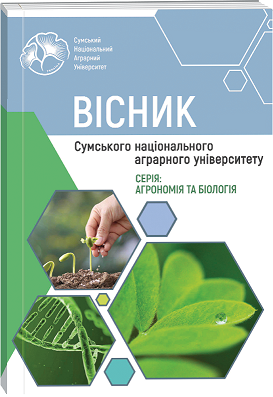YIELD OF GRAIN SORGHUM DEPENDS ON FERTILIZER AND VARIETAL CHARACTERISTICS
Abstract
Grain sorghum (L.) is a valuable crop with high yields. The crop future perspective depends on the ability of producers to apply optimal growing technologies. The general prerequisite for high yields of sorghum crops is the most efficient satisfaction of plant needs during the growing season, that is, the use of necessary chemical nutrients. Sorghum yields can be significantly increased by providing adequate nutrients. Fertilizer management affects not only yield but also the quality of the final product. Providing sorghum crops with adequate doses of fertilizers assist in maximising of yields. That is, research is needed on the selection of sorghum varieties optimal for the growing zone and the application of appropriate elements of technology, in particular, determining the optimal rates of mineral fertilizers that can ensure high yields in the northeastern forest-steppe zone of Ukraine, which was the goal of our research. The research was conducted during 2021-2023 at the educational and scientific field of Sumy National Agrarian University. The experiment repetition was trice, the plot placement was systematic. Factor A – hybrid and varieties of grain sorghum: Yankee, Dniprovsky 39, Samaran 6. Factor B – fertilizer rate: variant without fertilizer application (control), Nitroammophos (N16P16K16), (N35P35K35.) and (N70P70K70) active ingredient kg/ha were applied for pre-sowing cultivation. The results showed that the use of fertilizer rates of N70P70K70 and N35P35K35 increased sorghum yield from 2.30 to 6.32 t/ha depending on genotypes. With increasing fertilizer rates, the value of the yield coefficient and crop weight increased. The highest yield coefficient was determined for the Yanki hybrid and the Samaran 6 variety with an average coefficient value of 35 – 37%. (fertilizer rates of N70P70K70 and N35P35K35) For Dniprovsky 39 and the Samaran 6 variety, the maximum level of yield increase was noted with application of N35P35K35 – 11, 8 kg and 5,52 kg of grain per 1 kg of active substance, respectively. For Yankee hybrid, the highest indicator values was 11.90 kg of grain per 1 kg of active substance with a maximum rate of N70P70K70. In general, for high level of yield, the optimal rates of fertilizer application were N70P70K70 and N35P35K35. The yield of Yankee hybrid and the Dniprovsky 39 variety was the highest in the experiment so they could be recommended for the growing under region conditions.
References
2. Ajeigbe, H. A., Akinseye, F.M., Kunihya, A. & Jonah, J. (2018), Productivity and water use efficiency of sorghum [sorghum bicolor (L.) moench] grown under different nitrogen applications in Sudan savanna zone, Nigeria Int’l Journal of Agronomy. doi: 10.1155/2018/7676058
3. Ajeigbe, H. A., Akinseye, F. M., Jonah, J.& Kunihya, A. Sorghum yield and water use under Phosphorus fertilization applications in the Sudan savanna of Nigeria (2018). Glo. Adv. Res. J. Agric. Sci. Global Advanced Research Journal of Agricultural Science, 7(8), 245–257. Access mode: http://garj.org/garjas/home
4. Akram, A., Fatima, M., Ali, S., Jilani, G. & Asghar, R. (2007) Growth, yield and nutrients uptake of sorghum in response to integrated phosphorus and potassium management. Pakistan Journal of Botany, 39, 1083–1087.
5. Alse, U. N., Bhutada, P. O. & Mehtre, S. P. (2019). Effect of time nitrogen fertilizer application on growth and yield of grain sorghum. Int. J. Curr. Microbiol. App. Sci., 8(5), 987–992. doi: 10.20546/ijcmas.2019.805.115
6. Amiri, M., Mojaddam, M., Shokouhfar, A. & Bakhtiarinejad, N. (2014). The effect of different levels and time of nitrogen application on grain yield, some physiological traits and nitrogen use effiency in grain sorghum. Indian J. Fundam. Appl. Life Sci., 4, 223–227.
7. Bayu, W., Rethman, N. F. G., Hammes, P. S., & Alemu, G. (2006). Effects of farmyard manure and inorganic fertilizers on sorghum growth, yield, and nitrogen use in a semi-arid area of Ethiopia. J. Plant Nutr. 29, 391–407.
8. Bollam, S., Romana, K. K., Rayaprolu, L., Vemula, A., Das, R. R., Rathore, A., Gandham, P., Chander, G., Deshpande, S. P. & Gupta, R. (2021) Nitrogen Use Efficiency in Sorghum: Exploring Native Variability for Traits Under Variable N-Regimes. Front Plant Sci., 12, 643192. doi: 10.3389/fpls.2021.643192.
9. Boiko, M. O. (2016). Analiz struktury vrozhaiu hibrydiv sorho zernovoho pry riznykh hustotakh posiviv za dvokh strokiv sivby. Ontohenez – stan problemy ta perspektyvy vyvchennia roslyn v kulturnykh ta pryrodnykh tsenozakh [Analysis of the grain structure structure of grain sorghum hybrids at different crop densities at two sowing dates. Ontogenesis – the state of the problem and prospects for the study of plants in cultural and natural coenoses]: Collection of abstracts of the international conference. Kherson, RVTs «Kolos», 79–80. (in Ukrainian)
10. Buah, S. S. J., Kombiok, J. M. & Abatania, L. N. (2012). Grain sorghum response to NPK fertilizer in the Guinea savanna of Ghana. J. Crop Improv., 26, 101–115. doi: 10.1080/15427528.2011.616625
11. Dembele, J., Gano, B., Kouressy, M., Dembele, L., Doumbia, M., Ganyo, K., Sanogo Sekouba, T., Adama, T., Karim, Vaksmann Michel, Témé Niaba, Diouf, D. & Audebert, A. (2021). Plant density and nitrogen fertilization optimization on sorghum grain yield in Mali. Agron. J., 113, 4705–4720. doi: 10.1002/agj2.20850
12. Desta, G., Amede, T., Gashaw, T., Legesse, G., Agegnehu, G., Mekonnen, K. & Whitbread, A. (2022). Sorghum yield response to NPKS and NPZn nutrients along sorghum-growing landscapes. Experimental Agriculture, 58, E10. doi: 10.1017/S0014479722000072
13. Dovale, J. C., Delima, R. O. & Fritsche-Neto, R. (2012) Breeding for nitrogen use efficiency. in Plant Breeding for Abiotic Stress Tolerance, eds R. Fritsche-Neto and A. Borem (Berlin: Springer), 53–65.
14. Ganyo, K. K., Muller, B., Ndiaye, M., Gaglo, E. K., Guisse, A. & Adam, M. (2019) Defining fertilization strategies for sorghum (Sorghum bicolor (l.) Moench) production under sudano-sahelian conditions: options for late basal fertilizer application. Agronomy, 9, 697. doi: 10.3390/agronomy9110697
15. Getinet, H. & Atinafu, O. (2022) Effect of phosphorus fertilizer rates on grain yield and yield components of sorghum (Sorghum bicolor L.) at Kersa District, Jimma Zone, and South western Ethiopia. J. of Aquac. Fisheries, 6, 049.
16. Gupta, N., Gupta, A. K., Gaur, V. S., & Kumar, A. (2012). Relationship of nitrogen use efficiency with the activities of enzymes involved in nitrogen uptake and assimilation of finger millet genotypes grown under different nitrogen inputs. The Scientific World Journal, 10.
17. Hailu, G. & Kedir, M. (2022) Effect of nitrogen and phosphorus fertilizer rates on yield and yield components sorghum (Sorghum bicolor L. Moench) at Kersa Woreda of Oromia Region. International Journal of Bioorganic Chemistry, 7(1), 23–29. doi: 10.11648/j.ijbc.20220701.14
18. Hasan, S. A., Rabei, S. H., Nada, R. M. & Abogadallah, G. M. (2017) Water use efficiency in the drought-stressed sorghum and maize in relation to expression of aquaporin genes., Biol. Plant, 61, 127–137.
19. Holman, J. D., Obour, A. K. & Mengel, D. B. (2019) Nitrogen application effects on forage sorghum production and nitrate concentration. J. Plant Nutr., 42, 2794–2804.
20. Hospodarenko, H. M., & Klymovych, P. V. (2006). Reaktsiia sorho zernovoho na udobrennia na chornozemi opidzolenomu [Reaction of grain sorghum to fertilizer on podzolic chernozem]. Collection of scientific works of Luhansk NAU, 69, 20–25 (in Ukrainian).
21. Ikanovic, J., Glamoclija, D.J., Maletic, R., Jankovic, S., Tabakovic, M., & Zivanovic, L. J. The genotype traits of forage sorghum, Sudan grass and their interspecies hybrid in the conditions of intensive nutrition. Genetika. 2010, 2, 349–358.
22. Ivanina, V. V., & Pashynska, K. L. (2022). Formation of nutritional balance in grain sorghum crops under different fertilizer systems. Bulletin of Sumy National Agrarian University. The Series: Agronomy and Biology, 47(1), 65–70. doi: 10.32845/agrobio.2022.1.9
23. Kaufman, R. C., Wilson, J. D., Bean, S. R., Presley, D. R., Blanco-Canqui, H. & Mikha, M. (2013). Effect of nitrogen fertilization and cover cropping systems on sorghum grain characteristics. J. Agric. Food Chem. 61, 5715–5719. doi: 10.1021/jf401179n
24. Legesse, H. & Gobeze, L. (2015) Growth and grain yield response of sorghum (Sorghum bicolor L. Moench) varieties to moisture conservation practices and NP Fertilizer at moisture stress area of Amaro, Southern Ethiopia. Ashese Journal of Agricultural Science, 1, 001–005.
25. Mahama, G. Y., Vara Prasad, P. V., Mengel, D. B. & Tesso, T. T. (2014). Influence of nitrogen fertilizer on growth and yield of grain sorghum hybrids and inbred lines. Agron. J. 106, 1623–1630. doi: 10.2134/agronj14.0092
26. Maliarchuk, N. P., Maliarchuk, A. S., Luzhanskyi, I. Yu, Markovska, E. E., & Maliarchuk, V. N. (2019). Vplyv system osnovnoho obrobitku ta udobrennia na humusovyi stan gruntu i produktyvnist sorho zernovoho u sivozmini ta zroshenni [Influence of basic tillage and fertilization systems on soil humus condition and grain sorghum productivity in crop rotation and irrigation]. Bioresources and nature management, 1–2, 98–107 (in Ukrainian). doi: 10.31548/bio2019.01.011
27. Masebo, N. & Menamo, M. (2016) The effect of application of different rate of N-P fertilizers rate on yield and yield components of sorghum (Sorghum Bicolor): Case of Derashe Woreda, Snnpr, Ethiopia. Journal of Natural Sciences Research, 6, 88–94.
28. McHenry, B. M. (2016). Balanced nutrition and crop production practices for the study of grain sorghum nutrient partitioning and closing yield gaps. M.Sc. thesis. Manhattan, KS: Kansas State University.
29. Metodyka derzhavnoho sortovyprobuvannia silskohospodarskykh kultur. Vypusk 2: Zernovi, krupiani ta zernobobovi kultury (2001). Za red. V. V. Volkodava. [Methodology of state variety testing of agricultural crops, 2: Cereal, cereal and leguminous crops]. Alefa, Kyiv, 65 [in Ukrainian].
30. Melaku, N. D., Bayu, W., Ziadat, F. & Strohmeier, S. (2017). Effect of nitrogen fertilizer rate and timing on sorghum productivity Ethiopian highland Vertisols. Arch. Agron. Soil Sci., 64, 480–491. doi: 10.1080/03650340.2017.1362558
31. Ostmeyer, T. J., Bahuguna, R. N., Kirkham, M. B., Bean S. & Jagadish, S. V. K. (2022). Enhancing Sorghum Yield Through Efficient Use of Nitrogen – Challenges and Opportunities. Front Plant Sci., Feb 28;13:845443. doi: 10.3389/fpls.2022.845443.
32. Qi, G., Li, N., Sun, X. S., Wang, D., Ciampitti, I. & Prasad, V. (2016). Overview of Sorghum industrial utilization, in Sorghum: A State of the Art and Future Perspectives, eds I. Ciampitti and V. Prasad (Madison WI: American Society of Agronomy and Crop Science Society of America, Inc.), 463–476. doi: 10.2134/agronmonogr58.c21
33. Rashid, A., Khan, R. U. & Ullah, H. (2008). Influence of nitrogen levels and application methods on yield and quality of Sorghum. Pedosphere 18, 236–241. doi: 10.1016/s1002-0160(08)60012-0
34. Sanders, J. H., Ouendeba, B., Ndoye, A. & Teme, N. (2018) Introducing new technologies and market strategies for sorghum producers in developing countries: the Sahel case W. Rooney (Ed.), Achieving Sustainable Cultivation of Sorghum Volume 2: Sorghum Utilization Around the World, Burleigh Dodds Science Publishing, Cambridge, UK.
35. Sebnie, W. & Mengesha, M. (2018) Response of nitrogen and phosphorus fertilizer rate for sorghum (Sorghum bicolor L. Moench) production in Wag-Lasta area of Ethiopia. Archives of Agriculture and Environmental Science, 3, 180–186.
36. Shibeshi, M. H., Gedamu, M. T. & Fiseha, A. M. (2022). The effects of nitrogen rates on yield, and yield components of improved sorghum varieties in the lower watersheds of Habru District, Northern Ethiopia. Abyssinia Journal of Science and Technology, 7(1), 46–53. Access mode: https://abjol.org.et/index.php/ajst/article/view/452
37. Temeche, D., Getachew, E. & Hailu, G. (2021) Effects of nitrogen fertilizer quantity and time of application on sorghum (Sorghum bicolor (L.) Moench) production in lowland areas of North Shewa, Ethiopia International Journal of Agronomy. doi: 10.1155/2021/3019528
38. van Oosterom, E. J., Borrell, A. K., Chapman, S. C., Broad, I. J. & Hammer, G. L. (2010a). Functional dynamics of the nitrogen balance of sorghum: I. N demand of vegetative plant parts. Field Crops Res., 115, 19–28.
39. Worland, B., Robinson, N., Jordan, D., Schmidt, S. & Godwin, I. (2017). Post-anthesis nitrate uptake is critical to yield and grain protein content in Sorghum bicolor. J. Plant Physiol., 216, 118–124. doi: 10.1016/j.jplph.2017.05.026
40. Yeshchenko, V. O., Kopytko, P. H., Opryshko, V. P. & Kostohryz, P. V. (2005). Osnovy naukovykh doslidzhen v ahronomii [Basic research in agronomy]. Diia, Kyiv, 288 [in Ukrainian].
41. Zhang, S.J., Chaudhry, A.S., Ramdani, D., Osman, A., Guo, X.F., Edwards, G.R. & Long, C. (2016) Chemical composition and in vitro fermentation characteristics of high sugar forage sorghum as an alternative to forage maize for silage making in Tarim Basin, China. J. Integr. Agric. 15, 175–182.

 ISSN
ISSN  ISSN
ISSN 



